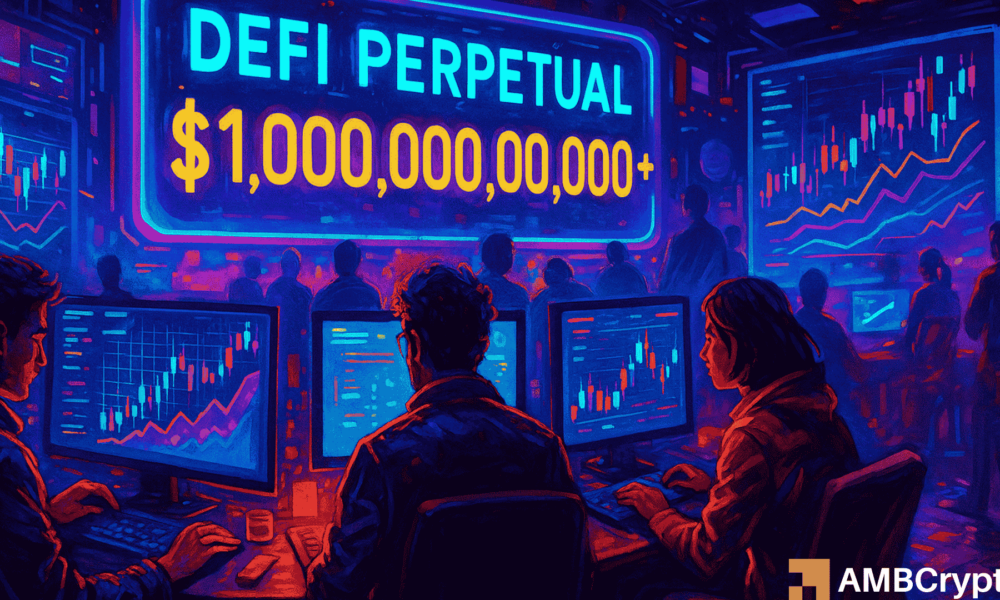The Rise of Decentralized Perpetual Futures: A $1 Trillion Milestone
In the crypto landscape, the recent crossing of $1 trillion in monthly trading volume for decentralized perpetual futures marks a monumental moment. This achievement signifies that decentralized finance (DeFi) is beginning to rival established traditional derivatives markets, illustrating the growing trust and adoption of on-chain trading solutions. As global traders increasingly leverage these platforms, it raises questions about the future of trading dynamics and the broader implications for the financial ecosystem.
A Shift Towards Decentralized Platforms
October 2023 saw decentralized perpetual futures record an impressive $1.05 trillion in trading volume, illustrating a significant shift from centralized exchanges towards less regulated environments. As more traders opt for on-chain solutions, DeFi is showing resilience and scalability that rivals legacy finance. Data from DeFiLlama indicates that daily turnover in DeFi perpetuals is roughly $45.7 billion, while open interest on these platforms has surged to $16 billion, signifying a strong commitment to decentralized trading rather than mere speculation.
Driving Forces Behind the Shift
Several factors drive this trend towards decentralized futures. One of the primary determinants is extremely low fees on Layer-2 networks that facilitate quicker and more cost-effective transactions. Traders also benefit from deep liquidity provided by stablecoins, making leverage in DeFi less expensive and faster when compared to typical centralized exchange fees. This heightened efficiency has undoubtedly attracted a substantial number of users eager to capitalize on better trading conditions.
Institutional Participation and High-Performance Platforms
The emergence of high-performance platforms like Hyperliquid, which processed over $316 billion in monthly volume, plays a crucial role in this shift. Hyperliquid’s volume even eclipsed the combined Bitcoin futures activity of prominent exchanges like Coinbase and Kraken during this period. Similarly, the platform Lighter, operating on Arbitrum, accumulated $259 billion in trading volume, emphasizing a trend where a few specialized and high-performance derivatives venues are gaining prominence over a multitude of fragmented decentralized exchanges.
Volatility and Market Conditions Favor DeFi
The remarkable figures emerging from October align closely with a notable increase in market volatility. With Bitcoin’s realized volatility surpassing 45%, funding rates have risen significantly, driving traders towards platforms that allow quicker execution and reduced collateral requirements. Furthermore, growing stablecoin settlement volumes, which have cumulatively surpassed $1.25 trillion year-to-date, provide decentralized perpetual markets with collateral pools essential for accommodating significant directional trades.
Disillusionment with Centralized Exchanges
Recent disturbances in centralized exchanges have catalyzed this migration towards decentralized alternatives. Operational issues, such as downtime caused by AWS, alongside increasing regulatory scrutiny towards platforms like Binance, have cultivated distrust among traders. The quick withdrawal of liquidity from platforms like Aster following the exposure of inflated volume activities showcases how swiftly traders are now willing to pivot when they lose confidence in centralized structures—a stark contrast to the slower responses seen in previous years.
Future Implications for Institutional Participation
As decentralized perpetual venues demonstrate remarkable growth, the potential for institutional flows to follow suit becomes increasingly intriguing. If this trend continues, decentralized platforms could not only match but also surpass the liquidity and speed found in centralized networks. The question remains: Will institutional desks begin routing leveraged flows on-chain? Will asset managers start using stablecoins for collateralization? The answers could delineate a fundamental shift in how crypto trading is conducted, potentially establishing a new era in the industry.
In conclusion, the impressive milestone for decentralized perpetual futures is more than just a number; it reflects a broader transformation in the trading ecosystem. As innovations continue to enhance user experiences and mitigate risks commonly associated with centralized platforms, we may be witnessing a pivotal moment that will redefine trading practices in the digital finance space.


